The TARDIS is one of Doctor Who’s most distinctive iconographic components and it performs as a space for narrative action, as a vehicle, as an object within a setting, and as a place that is inhabited. In this post I want to link together some ideas about how the TARDIS functions aesthetically, with ideas about how it enables and constrains the production of Doctor Who. That connection between aesthetics and production practices derives from the work the “Spaces of Television” research team has been doing, and it led to my previous post about cars in police drama.
The TARDIS is a vehicle for moving in time and space, and thus it is a means for the series to explore a potentially infinite number of story-worlds. The materialization of the TARDIS announces the here-and-now of the story, and it can appear consistently in a range of different settings: in production it can be quite simply represented by a prop deployed in the studio or on location. It can also be represented by models of different sizes, like the miniature TARDISes of “Carnival of Monsters” (pictured, 1973) or “Logopolis” (1981).
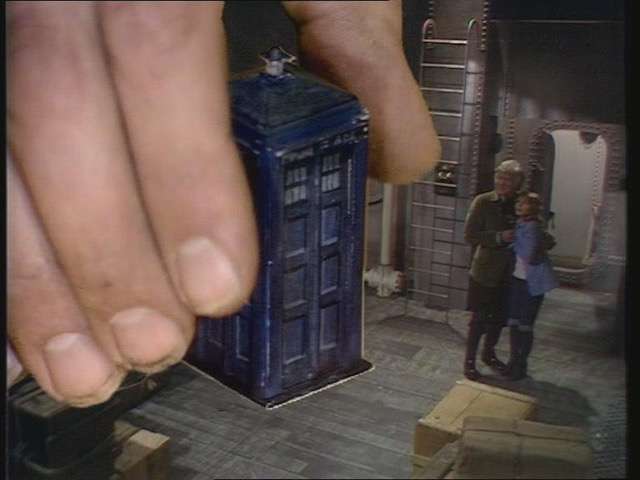
Tardis Model
The way these props and models are shot will indicate scale and establish a place. Most often, the TARDIS is a police box in a time where it does not belong, but “Logopolis” plays with this motif by having the same police box represent three different things. It is a “real” police box that stranded air-hostess Tegan tries to use to ring for roadside assistance. It is also the Master’s TARDIS, which he has, unusually, configured to look the same as the Doctor’s. And finally there is the Doctor’s TARDIS which materializes in the same space as the Master’s, causing a recursive loop. The same object (the same prop) performed as three different objects, in the same place.
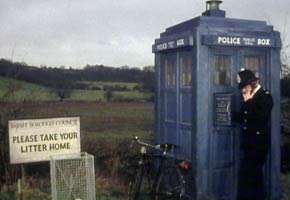
Tardis as Police Box
There are several ways in which the TARDIS works as a threshold between spaces and places. From a production point of view, it sutures two different settings together so that separately shot sequences are narratively connected. As well as being a vehicle, it is also a sort of doorway that opens so the Doctor, his companions and the viewing audience, can experience a new place. It contains further portals within it, in the form of a monitor screen that can show the outside, but primarily the Doctor exits through the doors to initiate the exploration of an as-yet unseen world. In production, that exterior was often a set put up somewhere else in the same television studio. But when film was used for exteriors, leaving the TARDIS meant departing from video onto film, and the exterior had a quite distinct visual quality because of the different lighting styles and image quality that film produced. The space outside the TARDIS really felt like another world because of this.
But the TARDIS is a setting with its own spatial characteristics too. One of the important consequences of the “bigger on the inside” motif is that while exterior shots of the TARDIS represent a relatively small object within a larger environment, the inside can be an environment in itself. Control Rooms were very consistent in classic studio-produced Who; in the new Who, single-camera shooting and the common use of Steadicam mean that although the new TARDIS is still a set, its creators aim to make it feel more like a location than a studio. Episodes of classic Who also feature the very numerous spaces within the TARDIS. The first episode in 1963 introduced the spatial distinction between outside and inside, and in 1978 in “The Invasion of Time” the pursuit of the protagonists through the TARDIS by the Sontarans is the occasion for representing many of its interior spaces, such as its swimming pool, art gallery and numerous corridors.
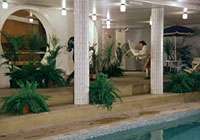
Tardis Swimming Pool
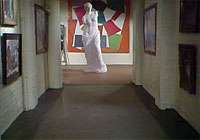
Tardis Gallery
Whereas TARDIS rooms had previously been constructed as studio sets and shot on video, the “Invasion of Time” sequences were shot on film in a brick building, so that these interiors have the same visual texture as location exteriors, rendering the TARDIS an action space in a disturbing and exciting way. Within the fictional world, the TARDIS can undergo expansions and contractions that make its space mutable and partially unknowable. While remaining a place, the dimensions of its space can change. And the technologies used to create and shoot the TARDIS give it different moods and ambiences at different times.
The TARDIS was attributed with agency quite early on in the series, in “The Edge of Destruction” (1964), when the odd behaviour and aggression amongst the Doctor and his companions was explained as being the result of the TARDIS warning them of its dangerous trajectory towards the beginning of the Universe. Much later, the new Who episode “The Doctor’s Wife” (2011) embodies the TARDIS as Idris, a human woman into which its essence has been transferred. It takes on a characterization. I am working at the moment on how long-running television programmes seem to give life to things, whether they are props, vehicles or places, and I think the TARDIS is a particularly good example. When I was lucky enough to touch a TARDIS recently, it was like shaking hands with a much-admired celebrity.
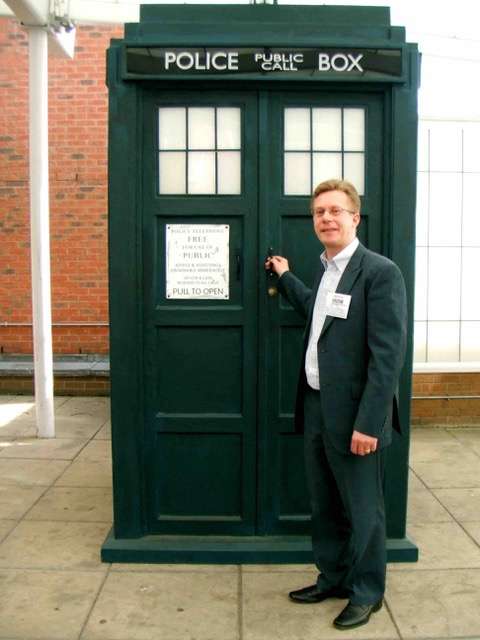
Touching the Tardis
Jonathan Bignell is Professor of Television and Film at the University of Reading. He currently leads the AHRC-funded research project “Spaces of Television: Production, Site and Style”, and this post benefitted from the Doctor Who expertise of “Spaces” colleagues Victoria Byard, James Chapman and Billy Smart. A longer version of this post was presented at the “Doctor Who: Walking in Eternity” conference, University of Hertfordshire, September 2013.




